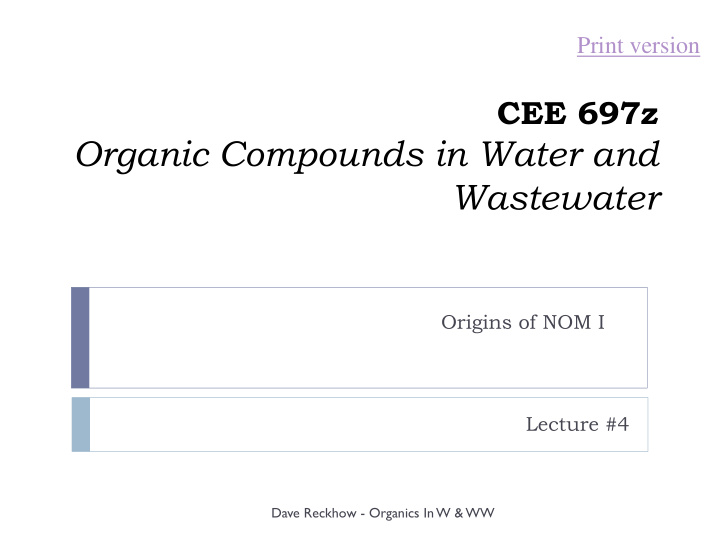



Print version CEE 697z Organic Compounds in Water and Wastewater Origins of NOM I Lecture #4 Dave Reckhow - Organics In W & WW
Outline Engineering Concerns NOM in Source Waters Origins Classifications Concentrations Characterization of NOM Basic properties It’s one of my favorite recipes. I call it Useful methods Humic Acid Reactions with Disinfectants Compounds formed Amounts formed: Precursor tests 2 2
Source of NOM Where Pedogenic Aquogenic Factors Geology Flora Climate Land use Hydrology 3
Some definitions Groupings Based on Origin autochthonous material is formed within the water body allochthonous material can originate from either the soil or from upstream water bodies aquagenic , substances originating from any water body pedogenic for substances originating from soil 4
Precursors:Watershed Origins Upper Soil Horizon Lower Soil Horizon Litter Layer Lake Algae Aquifer Sediment & Gravel in Lake Bed 5
Watershed Origins Lake Algae Aquifer Sediment & Gravel in Lake Bed 6
DOC Generation What do we know? Start with the “building blocks” Link to chemical characterization “I think you should be more explicit here 7 in step two”
The terminology Humic substances Fulvic & Humic Acid Non-humics Many are Structurally Defined Many are simple plant products Tannins, Aromatic Acids and Phenols Carbohydrates, sugars Fatty Acids Amino Acids and Proteins T erpenoids Miscellaneous Low MW Compounds Acylheteropolysaccharides are in this group too Structural sugars containing nitrogen 8 8
NOM: Origins & Behavior Humic substances (humic and fulvic acids) Organic detritus modified by microbial degradation lignin origin vs microbial resistant to further biodegradation “old” organics easier to remove by coagulation Non-humics & Structurally-defined groups may be relatively “new” includes many biochemicals and their immediate degradation products generally more biodegradable concentrations are highly variable with season 9
Origins Humic substances (humic and fulvic acids) Organic detritus modified by microbial degradation lignin origin vs microbial resistant to further biodegradation “old” organics Non-humics & Structurally-defined groups may be relatively “new” includes many biochemicals and their immediate degradation products generally more biodegradable concentrations are highly variable with season 10
CO 2 NOM Types Vascular Plants Three Algae Biodegradation NOM h ν Pools Simple Plant Products :Nu El Humic Acylhetero Substances polysaccharides 11
Simple Plant Products: Metabolic Pathways Steroids Nucleic Porphyrins Acids Water Soluble Acids Terpenoids Amino Acids Misc. N & S Mevalonic acid compounds Acetate Flavonoids Unsaponifiable Liquids Pyruvate Proteins Shikimic Acid Saponifiable Liquids Carbohydrates Nitrogenous Aromatic Compounds precursors 12 From: Robinson, 1991 Activated non-N precursors
Aged leaves from 3 locations in Wachusett watershed Leaching Experiments White White Red Oak Pine Maple 13
Plant biopolymers Cellulose Lignin Phenyl-propane units Cross-linked Radical polymerization Ill defined structure Hemicellulose Terpeniods Proteins
Leaching Rates Leaching rates from the scientific literature Amount released each week Diminishes with time for some, accelerates for others From: Magill and Aber, 2000 Soil Biology & Biochemistry, vol. 32, pp.603-613
Composition of an “average” leaf 250 g/m 2 /yr EABP Highly- colored Some color 16 Dave Reckhow
Variations based on Species Source: Terrestrial Ecosystems Aber & Melillo 2 nd edition Harcourt Academic Press
Colored Compounds Phenolic Acids Readily released, highly colored Lignin Very slowly released, some color
Colorless Compounds Simple sugars Readily released, highly biodegradable Starch Easily released and also biodegradable Cellulose & Hemicellulose Slow to solubilize, not easily degraded
Constituents degrade at different rates “Solubles” go first Free carbohydrates are next Bound or Lignified carbohydrates and Lignin are last
Solubilization vs Total Loss DOC-C loss versus total C loss in mg C. Maple Y -axis values are mean leached DOC concentration for the 15 week treatment Oak X -axis values are total C loss from litter. Pine Re-drawn from Magill and Aber, 2000
H OH Chemical Tannins, Aromatic Acids C C Symbols C C OH and Phenols C C H OH • About 0.5% of Total HO • Plant Products OH H HO O • Likely THM Precursors OH • Source of Color & DBPs HO H H O OH HO H OH H 2 Condensed Tannin HO C O C HO O CH OH HO Gallic Acid monomers HO C O CH HO O CH OH HO Hydrolyzable Tannin HO C O CH 2 22 HO
Tannins, Aromatic Acids and Phenols, cont. • Lignin monomers COOH COOH OCH 3 OH OH Vanillic Acid p-Hydroxybenzoic Acid 23
Lignin From: Perdue & Ritchie, 2004 24
Lignin degradation Oxidation of model lignin by ligninase & H 2 O 2 (from Kirk & Farrell, 1987) 25
To next lecture Dave Reckhow - Organics In W & WW
Recommend
More recommend